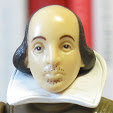 Midsummer Night’s Dream. Dir. Joe Dowling. Perf. Nic Few, Emily Swallow, Kathryn Lawrey, William Sturdivant, Jonas Goslow, Valeri Mudek, Namir Smallwood, and Stephen Pelinsky. Guthrie Theatre Company. Minneapolis. 12 April—22 June 2008.
Midsummer Night’s Dream. Dir. Joe Dowling. Perf. Nic Few, Emily Swallow, Kathryn Lawrey, William Sturdivant, Jonas Goslow, Valeri Mudek, Namir Smallwood, and Stephen Pelinsky. Guthrie Theatre Company. Minneapolis. 12 April—22 June 2008. So many things about the Guthrie’s production were Shakespearean. Here’s a quick list.
The Text is Shakespeare
I suppose that’s an obvious one, but it’s not one that guaranteed in modern productions. The Guthrie paid careful attention to conveying the meaning of the text. Titania’s speech about how “The seasons alter: hoary-headed frosts / Fall in the fresh lap of the crimson rose” (II.i.107-08) was one such. It isn’t just that Minnesota has had some freak April snow showers—the actor brilliantly conveyed the message (and her fairies responded accordingly, showing the audience how we might respond).
The Costumes are Outrageous
The outrageous costumes were worth seeing in themselves. In Shakespeare’s theatre (we suppose), more was spent for costumes than for the play itself.
The Puritans of Shakespeare’s day were offended at the over-effusive and even illegal costumes. And they would have been offended at the underwear, too.
Men Dressed as Women is Funny on the Stage
We see this in the Pyramus and Thisbe section. The boy delegated to play Thisbe hasn’t been looking forward to dressing as a woman. But, when it came time for the show to go on, there was no holding him back. Each time he re-entered (in a different costume each time), the audience exploded in laughter.
Death Scenes aren’t Always Convincing
When Hamlet says, “I am dead, Horatio,” it frequently gets an unintended chuckle. Pyramus’ “Now am I dead / Now am I fled” gets the same reaction—intended, this time.
Songs and Dances Throughout—and a Huge Dance Number to Conclude
It may seem odd that all the dead bodies at the end of Hamlet got up to do a rousing country dance at the end, but that’s what happened. Perhaps it seems more appropriate at the conclusion of a comedy than at the end of a tragedy, but it’s Shakespeare all the way!








No comments:
Post a Comment